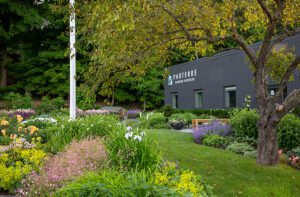A Passion for Pottery
July 31, 2012
Text by Maria LaPiana
A hard spring rain is falling, the kind that forms angry little vees when it hits the pavement. But Frances Palmer is smiling as she descends the stone steps in front of her studio, a rebuilt barn in Weston. A small woman with short, curly hair, Palmer wears retro well: cat’s-eye glasses, flax-colored slacks, vintage cardigan sweater. “Come in,” she says. “This is where it all happens.”
There’s clutter everywhere: industrial shelving, kilns, potter’s wheels, molds, shipping boxes, tiny seedlings in starter pots on the floor. In one corner, a roll of seamless backdrop paper is unfurled on a table with a single small vase on it: the photo studio. Palmer points to her new woodstove and her smile widens. “I got it to keep the barn warm, of course, but it turned out to be a brilliant idea,” she says excitedly. “It’s just incredible how quickly pots dry now!”
Palmer is a self-taught, self-made ceramic artist whose critically acclaimed work is shown in galleries and sought after by collectors. Her hand-thrown pieces exact considerable sums, but at the end of the day, she’s nothing close to an art diva; she’s a woman with a passion for clay.
The tour continues up narrow stairs to a room filled with finished pots and vases, bowls, plates, platters, cups and cake stands, in glazes and finishes ranging from earthy brown to muted cream and shiny white. It’s from here that Palmer runs her business. Her small desk sits at a window overlooking the flower garden—another one of her passions—overflowing with her favorite blooms, some 140 varieties of dahlias.
Palmer, who studied art history at Columbia, started making art of her own twenty-six years ago when she and her husband, a menswear designer, moved to Connecticut with a newborn. “I signed up for a throwing class, and I loved it,” she says. “In the beginning, I painted on my pots. I wanted to use clay as my canvas. But after a few years, the form took over.”
Looking out at the drenching rain, Palmer is content to tell her story on this dreary afternoon, because “it’s not a good throwing day anyway…it’s too wet, and the clay is leaden.”
“It’s really the nature of the process—the shaping, the firing—that I love,” she says. “And I love gardening and ceramics because I like the idea of having something in my brain and then actualizing it.”
Noted for glazed white pieces that are ribbed, furled, fluted, folded and adorned with flowers, ruffles and beads, Palmer’s work is perfect in its imperfection. And as her artistry has evolved, she says she’s as mad about terra-cotta as she is about porcelain; it just depends on the day. “Each clay has its own personality,” she says. “Some potters have a particular clay they like to work with. Not me. I’m intrigued by all kinds.”
She collects a few pieces from around the room, cradling them gently, and lines them up on a weathered worktable: her Paper Bag vases, so thin at the top that the clay folds onto itself; her Horn vase, delicate with a beaded rim; a diminutive Shane pot with a nice wide mouth, “perfect for flowers.” For an upcoming exhibition, she’s working with simple, unglazed porcelain fired at temperatures so high it becomes vitrified.
And then there are her celadon porcelain bowls, a current favorite. “I mix the glazes by hand and spray them on. I put a bowl in the kiln and wait. I never know exactly how it’s going to look,” she says. “I love to throw this clay!”
As much as Palmer is engaged by her art, she’s all business when she has to be. She employs only a single assistant and a bookkeeper, and she takes orders herself; those for manufactured pieces are forwarded directly to her factory in Buffalo, New York.
It’s a pretty small shop. “Do I wish I were making a million dollars?” she asks. “Sure. But I’m pleased knowing that my handmade work is progressing. There’s only so much I can make, but I’m doing something I believe in, and it comes through.” •
Editor’s Note To see more of Frances Palmer’s work, visit www.francespalmerpottery.com.
Share
![NEH-Logo_Black[1] NEH-Logo_Black[1]](https://b2915716.smushcdn.com/2915716/wp-content/uploads/2022/08/NEH-Logo_Black1-300x162.jpg?lossy=1&strip=1&webp=1)













You must be logged in to post a comment.